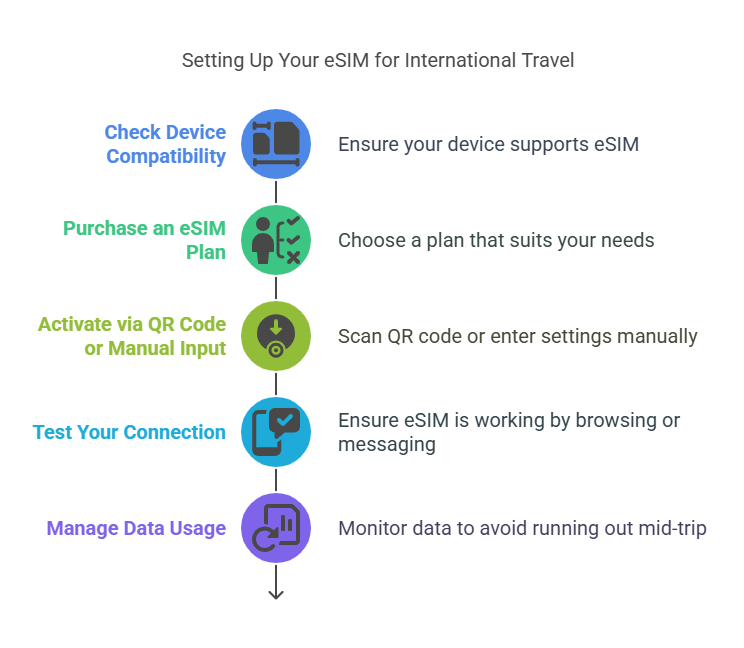This blog will walk you through everything you need to know about eSIMs, including their benefits, cost, setup, and answers to frequently asked questions. By the end, you’ll see why making the switch to eSIM technology is a smart move for your next adventure.
What Is an eSIM and How Does It Work?
An eSIM, short for embedded SIM, is a digital alternative to a traditional physical SIM card. Instead of swapping out tiny pieces of plastic whenever you switch networks or countries, you can simply download a mobile data plan to your compatible device. This makes an eSIM for international travel a hassle-free option for staying online.
The technology works by embedding a chip into your device. After purchasing a compatible eSIM plan, you scan a QR code or input the settings provided by the eSIM provider to activate the connection. That’s it! No physical cards. No waiting. Just seamless connectivity.

Why Choose an eSIM for International Travel?
1. Convenience
An eSIM lets you switch to a local data plan without physically removing or replacing your current SIM card. This is especially useful for frequent travelers, business professionals, or digital nomads.
- No need to carry multiple physical SIM cards.
- Activate regional or global plans before departure.
- Easily switch between personal and travel data profiles.
2. Cost Savings
Many eSIM for international travel plans are more cost-effective than roaming fees from your home carrier. By using a local provider or a global eSIM plan, you avoid the sticker shock of international roaming bills.
- Coverage in multiple countries within a single plan.
- Local rates that are often cheaper than roaming.
3. Flexibility
eSIMs enable you to connect to the best networks in real-time. Whether you’re hiking through Europe or exploring Southeast Asia, you can avoid spotty connections by selecting a reliable provider wherever you are.
4. Eco-Friendly
Since eSIMs eliminate the need for physical SIM cards, they reduce plastic waste. Choosing this digital-first option is a small step toward greener travel.

How Much Does an eSIM Cost?
The cost of eSIM plans depends on factors like the destination, data allowance, and duration. Here’s a general breakdown:
- Short-Term Plans (1 to 7 days): $5–$15
- Medium-Term Plans (2 to 4 weeks): $20–$50
- Long-Term Plans (1 to 6 months): $60–$150
Some eSIM providers offer global coverage, allowing you to use one plan across multiple countries. While these are convenient, they might be slightly more expensive than country-specific options.
Pro Tip: Use Terminal eSIM to filter and compare plans to find one that balances coverage, data, and budget.
How to Set Up Your eSIM for International Travel
Setting up an eSIM is simpler than you think. Most providers offer step-by-step instructions during the purchase process. Here’s a general guide:
- Check Device Compatibility
Ensure your smartphone, tablet, or laptop supports eSIM. Popular models include the latest iPhones, Samsung Galaxy devices, and Google Pixel. - Purchase an eSIM Plan
Choose a plan that suits your needs. For example, Terminal eSIM offers a variety of options, from regional plans to multi-country coverage. - Activate via QR Code or Manual Input
After purchasing, you’ll receive a QR code or activation details.- Open your settings and go to “Add Cellular Plan.”
- Scan the QR code or enter settings manually.
- Test Your Connection
Once activated, ensure that your eSIM is working by browsing the internet or sending a quick message. - Manage Data Usage
Use your device’s built-in data monitoring tools to avoid running out of data mid-trip.

Common Questions About eSIMs
1. What devices support eSIMs?
Most modern smartphones, tablets, and some laptops support eSIM. The iPhone XR and newer, Samsung Galaxy S20 and later, and Google Pixel devices are popular examples.
2. Can I use an eSIM alongside a physical SIM card?
Yes! Many devices allow dual-SIM functionality, where you can keep your physical SIM for calls while using an eSIM for data.
3. Is an eSIM more secure than a physical SIM?
Yes, an eSIM is harder to steal or physically tamper with, making it a more secure option.
4. Can I reuse the same eSIM for future trips?
No, eSIMs are typically tied to specific plans or providers. However, you can download a new eSIM profile for your next trip.
5. How long does it take to activate an eSIM?
Activation is almost instant, typically taking a few minutes after scanning your QR code.
Wrapping Up: Why eSIMs Are Perfect for Your Next Adventure
Switching to an eSIM for international travel means saying goodbye to roaming fees, physical SIMs, and connectivity hassles. Whether you’re trekking through remote trails or closing deals abroad, an eSIM ensures you stay connected with flexibility and ease.
Don’t leave your connectivity to chance. Explore your options on Terminal eSIM to compare data plans tailored to your next trip. Your seamless travel experience starts here!



